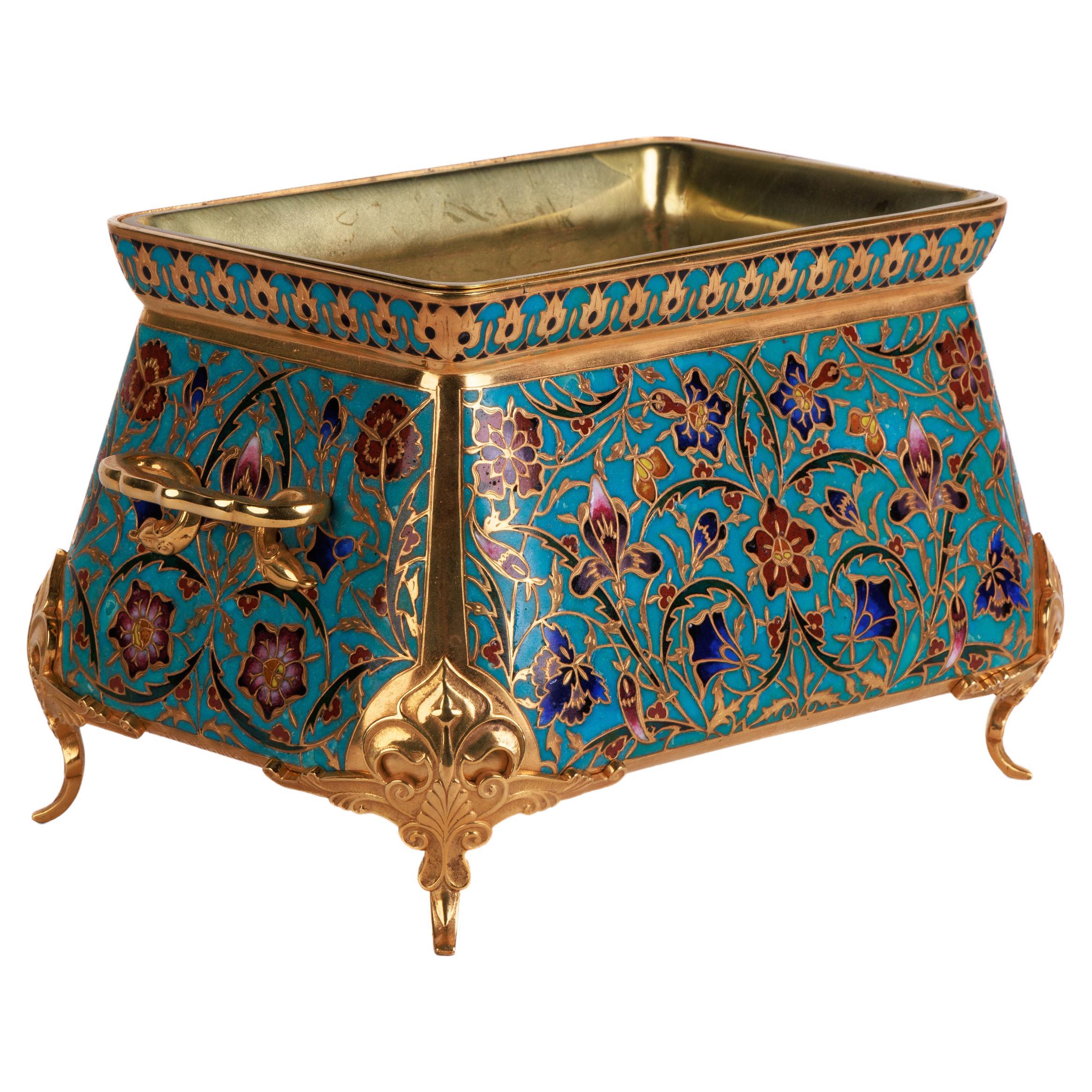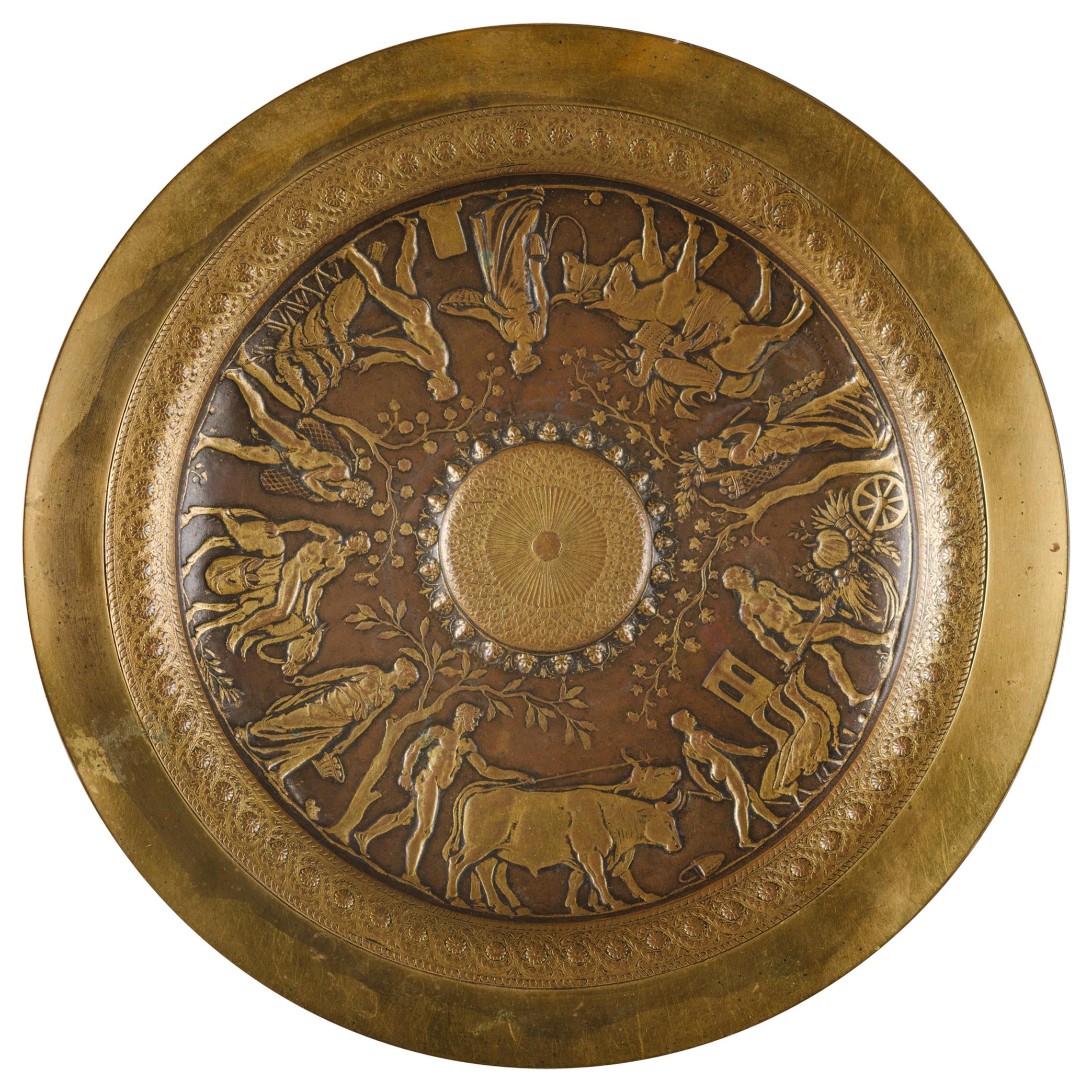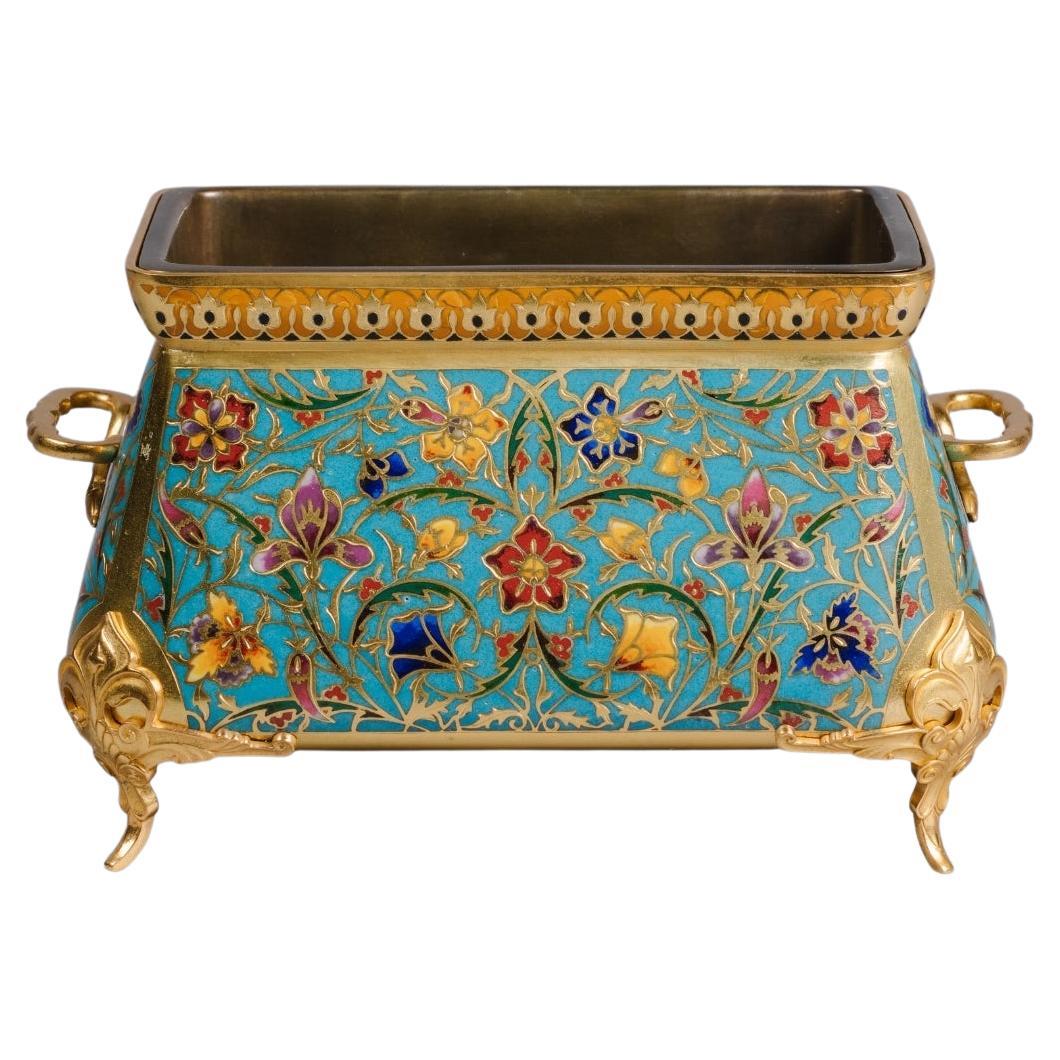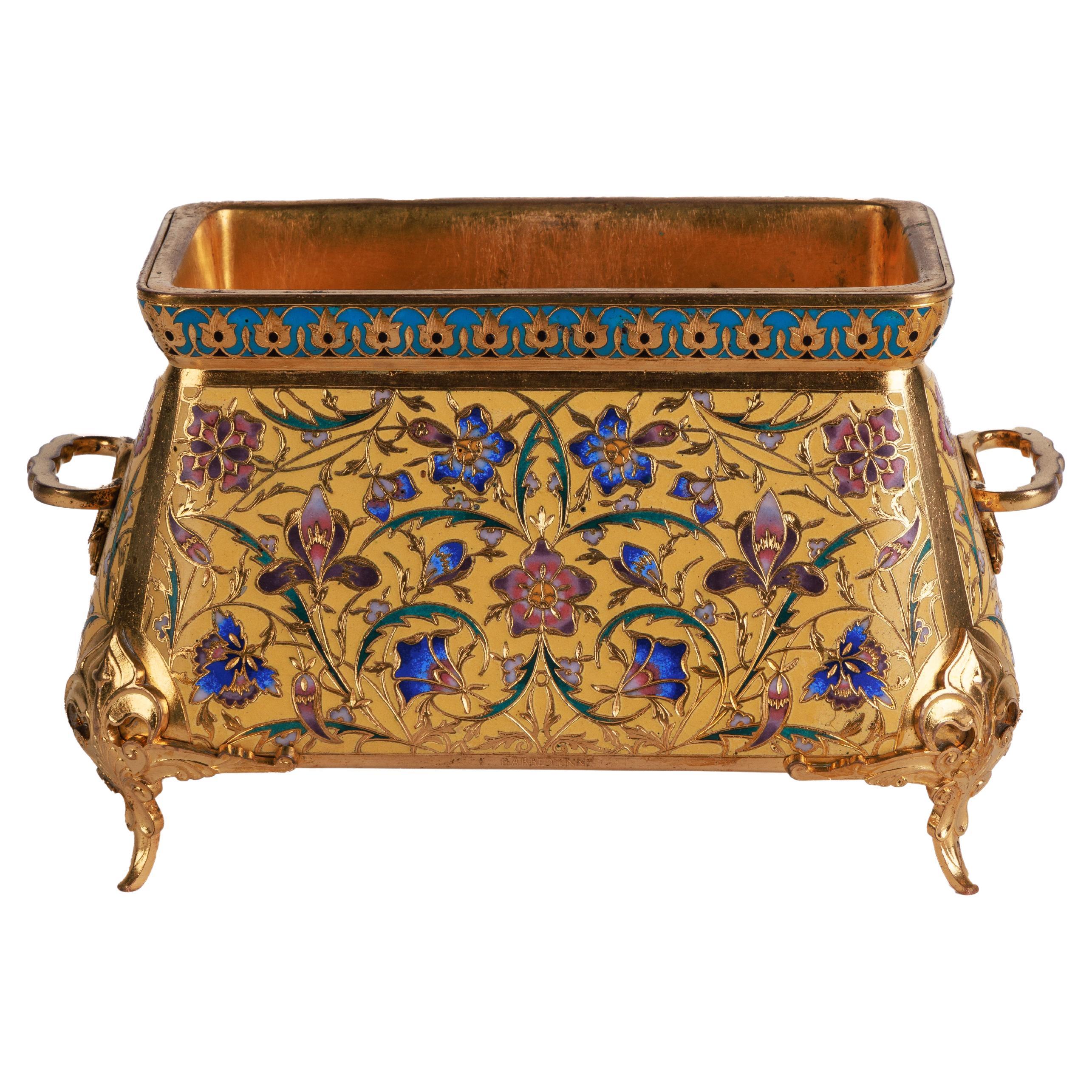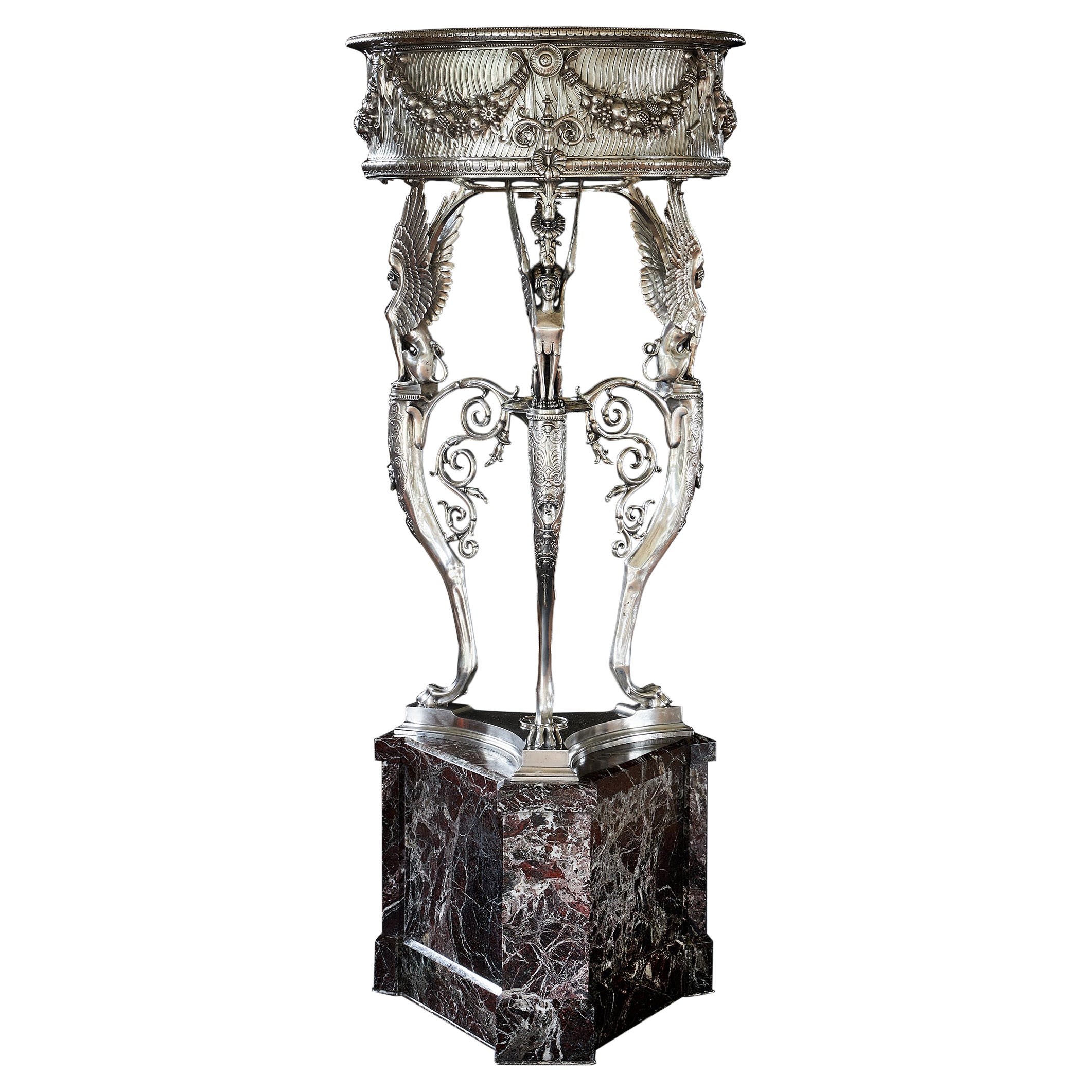Items Similar to Large and Finely Cast Neo-Grec Jardinière by Ferdinand Barbedienne
Want more images or videos?
Request additional images or videos from the seller
1 of 8
Large and Finely Cast Neo-Grec Jardinière by Ferdinand Barbedienne
About the Item
A large and finely cast neo-grec gilt and patinated bronze jardinière by Ferdinand Barbedienne.
Signed 'F. BARBEDIENNE'.
This rare Jardinière or planter is a fine example of the 'Neo-Grec' or ‘Pompeian’ style modelled after the antique, which featured prominently in Barbedienne's submissions to the 1855 Paris ‘Exposition Universelle’ and throughout the firm’s production.
Of rectangular form, the modelling is typical of the high-quality work Barbedienne produced at this time, finely cast in bas-relief with a procession of classical figures and animals, with foliate cast handles and exuberant fronded acanthus to each corner, terminating in claw feet.
French, Circa 1870.
- Creator:Ferdinand Barbedienne (Maker)
- Dimensions:Height: 11.82 in (30 cm)Width: 31.11 in (79 cm)Depth: 11.82 in (30 cm)
- Style:Neoclassical Revival (Of the Period)
- Materials and Techniques:
- Place of Origin:
- Period:
- Date of Manufacture:circa 1870
- Condition:Wear consistent with age and use.
- Seller Location:Brighton, GB
- Reference Number:
About the Seller
5.0
Recognized Seller
These prestigious sellers are industry leaders and represent the highest echelon for item quality and design.
Established in 1964
1stDibs seller since 2014
48 sales on 1stDibs
Typical response time: 1 hour
Associations
The British Antique Dealers' AssociationLAPADA - The Association of Arts & Antiques Dealers
- ShippingRetrieving quote...Ships From: Brighton, United Kingdom
- Return PolicyA return for this item may be initiated within 7 days of delivery.
More From This SellerView All
- Neo-Grec Gilt and Patinated Bronze Tazza, Cast by BarbedienneBy Ferdinand Barbedienne, Ferdinand LevillainLocated in Brighton, West SussexA Neo-Grec gilt and patinated bronze Tazza, designed by Ferdinand Levillain and cast by Ferdinand Barbedienne. Marked 'F. Levillain' to the decoration and stamped 'F. Barbedienne' to the underside. This rare tazza is a fine example of the collaboration between the gifted designer Ferdinand Levillain and the highly acclaimed bronzier Ferdinand Barbedienne. It is decorated with a bas-relief in the 'Neo-Grec' or ‘Pompeian’ style with classical figures herding animals...Category
Antique 19th Century French Neoclassical Revival Decorative Dishes and V...
MaterialsBronze
- A Champlevé Enamel Jardinière by Ferdinand BarbedienneBy Louis-Constant Sevin, Ferdinand BarbedienneLocated in Brighton, West SussexA Champlevé Enamel and Gilt-Bronze Mounted Jardinière by Ferdinand Barbedienne, the design attributed to Louis-Constant Sévin. This fine jardinière is decorated all over with foliate...Category
Antique 19th Century French Planters, Cachepots and Jardinières
MaterialsBronze, Enamel
- Large Pair of Neo-Grec Gilt and Patinated Bronze Amphora VasesBy Ferdinand BarbedienneLocated in Brighton, West SussexA rare and large pair of neo-grec gilt and patinated bronze amphora vases. Designed by Ferdinand Levillain and cast by Ferdinand Barbedienne. Signed ‘F. Levillain’ and ‘F. Barbedienne’. These spectacular floor-standing Neo-Grec vases...Category
Antique 19th Century French Neoclassical Vases
MaterialsBronze
- Pair of ‘Neo-Grec’ Style Multipatinated Bronze Amphora VasesBy Ferdinand Barbedienne, Ferdinand LevillainLocated in Brighton, West SussexA Large And Rare Pair of ‘Neo-Grec’ Style Multipatinated Bronze Amphora Vases by Ferdinand Levillain and Ferdinand Barbedienne. Signed to the cast ‘F. Levillain Fecit 1880’ and ‘F. Barbedienne’. This large pair of multipatinated vases are of amphora form modelled in the ‘Neo-Grec’ style with trumpet shaped necks and scrolling handles terminating in masks; the vases are raised on circular spreading bases put down on plinths. Each vase is finely ornamented with laurel leaves and garlands to the neck, the main body with a superb banded frieze cast in low relief depicting the Centauromachy. In the Centauromachy, the Lapiths battle with the Centaurs at the wedding feast of Pirithous. An enduring classical theme linked with the idea of culture versus nature, the Centauromachy was widely depicted in ancient Greece from the Southern Metopes of the Parthenon Freieze to the Temple of Apollo Epikourious at Bassai, it also appears as a subject on numerous Attic vases such as the Ilioupersis krater. A popular theme for artists from the Renaissance onwards it was depicted by amongst others, Michelangelo, Piero di Cosimo, Luca Signorelli, Sebastiano Ricci...Category
Antique 19th Century French Neoclassical Vases
MaterialsMarble, Bronze
- Chinese-Style Porcelain Vase In The Manner of Ferdinand BarbedienneBy Ferdinand BarbedienneLocated in Brighton, West SussexA Gilt-Bronze Mounted Chinese-Style Porcelain Vase With Dragon Handles and Elephant Head Feet, In the Manner of Ferdinand Barbedienne. Frenc...Category
Antique 19th Century French Chinoiserie Vases
MaterialsOrmolu
- Neoclassical Style Gilt-Bronze Gueridon Attributed to Ferdinand BarbedienneBy Ferdinand BarbedienneLocated in Brighton, West SussexAn unusual neoclassical style gilt bronze Gueridon with an inlaid black marble top, in the manner of Ferdinand Barbedienne and Louis-Constant Sévin. This unusual Gueridon has a ci...Category
Antique 1860s French Neoclassical Revival Gueridon
MaterialsBelgian Black Marble
You May Also Like
- Ferdinand Barbedienne, a French Ormolu and Champleve Enamel Jardiniere, C. 1870By Louis-Constant Sevin, Ferdinand BarbedienneLocated in New York, NYFerdinand Barbedienne, A French Ormolu and Champleve Enamel Jardiniere, C. 1870, The Design Attributed to Louis Constant Sevin. An exceptional qualit...Category
Antique 19th Century French Napoleon III Decorative Bowls
MaterialsBronze, Enamel, Ormolu
- Ferdinand Barbedienne, A French Ormolu and Champleve Enamel Jardiniere, C. 1870By Louis-Constant Sevin, Ferdinand BarbedienneLocated in New York, NYFerdinand Barbedienne, A French Ormolu and Champleve Enamel Jardiniere, C. 1870, The Design Attributed to Louis Constant Sevin. An exceptional qualit...Category
Antique 19th Century French Napoleon III Planters, Cachepots and Jardini...
MaterialsBronze, Enamel, Ormolu
- Neo-Grec Bronze and Patinated Bronze Tazza by F. Levillain, Cast by BarbedienneBy Ferdinand LevillainLocated in Knivsta, SEA beautiful Neo-Grec Tazza in bronze and patinated bronze, signed by the artist Ferdinand Levillain ( 1837-1905) and cast by the famous Ferdinand Barbedienne (1810-1892). France 1...Category
Antique 1860s French Centerpieces
MaterialsBronze
- 19th Century Silvered Bronze Athénienne Jardinière by Ferdinand BarbedienneBy Ferdinand BarbedienneLocated in Oxfordshire, United KingdomA French silvered-bronze athénienne by Ferdinand Barbedienne, Paris, last quarter 19th century with a revolving liner, the frieze applied with bucrania suspending ribbon-tied berried laurel swags above a border of bellflowers on a stippled ground above three seated female sphinxes issuing stylised foliage and scrolls on lion monopodia cast with the mask of Hercules, scrolling foliage and anthemions joined by stretchers, raised on a concave-sided triform marble base on a further thin silvered-bronze base, inscribed to the tripod base 'F. BARBEDIENNE' Measures: 103.3cm. high, 41.5cm. diameter; 3ft. 4 3/8 in, 1ft. 4 1/4. This impressive athénienne is a key reminder of the longevity of a particular model and design’s success from Antiquity through to the 19th century and up until this day. Typically known as the ‘Trépied du Temple d’Isis’, this athénienne is designed after the Roman antique originally found at Pompeii and now at the Museo Archeologico Nazionale, Naples (fig.1). From being for example an inspiration for the baptismal font of Napoléon’s son in 1811, this model was the inspiration to many highly skilled makers throughout the 19thcentury such as the Manfredini brothers from Milan and of course the Parisian well-established bronze founder Ferdinand Barbedienne who executed the present example. The Temple of Isis was a Roman temple dedicated to the Egyptian goddess Isis and was among one of the first discoveries during the excavation of Pompeii in 1764. Certainly considered as one of the most elegant examples of antique tripods, the existence of this model was then popularized to the rest of Europe via prints, one of the first being by Giovanni Battista Piranesi in 1779. This type of tripod was also popularised by an engraving in C. Percier and P. Fontaine’s, Receuil de Décorations Intérieures of 1801. Interestingly, there is also a watercolour now in the Musée Carnavalet, Paris, showing this type of tripod displayed at the 1801 Exposition des Produits de L’Industrie in the Louvre. The passion for Greek and Roman Art in the 19th century. The discovery of Pompeii and Herculaneum around the middle of the 18th century gave rise to a new passion for Antiquity and the excavated masterpieces renewed the repertoire of fine and decorative arts and served as models for Neoclassicism. Members of the aristocracy as well as connoisseurs, particularly in England, completed their education by undertaking a ‘Grand Tour’ of Italy and often fell victim to the recently unearthed Greek and Roman artefacts...Category
Antique 19th Century French Grand Tour Planters, Cachepots and Jardinières
MaterialsMarble, Silver Plate, Bronze
- Fine Pair of Parcel-Gilt and Patinated Bronze Neo-Grec Bronze Barbedienne VasesBy Ferdinand BarbedienneLocated in New York, NYFine pair of parcel-gilt and patinated bronze neo-grec bronze vases and rouge griotte marble. Designed by Ferdinand Levillain, cast by Ferdinand Barbedienne. Signed 'F. LEVILLAIN' , ...Category
Antique 19th Century French Vases
MaterialsBronze
- Large Neo-Greek Vase by F. Levillain & F. Barbedienne, France, circa 1890By Ferdinand Barbedienne, Ferdinand LevillainLocated in PARIS, FRImportant neo-Greek vase in the shape of an Amphora, made in two patina bronze. The body is decorated with a rich continuous frieze in bas-relief presenting a procession of characters carrying their offerings to the temple, underlined by a decoration of theatrical masks among olive trees. The 's'-scroll handles decorated with grape vines, resting only on the shoulder of the vase, are supported by a ram’s head. Numerous palmettes and friezes adorn the whole. Resting on a molded marble circular base. Biography Ferdinand Levillain (Paris, 1837-1905) studied under the sculptor Jouffroy (1806-1882), before making his debut in 1861 at the French Artists Salon where he continued to exhibit until 1903. At the 1867 Universal Exhibition in Paris, he was praised for a Neo-Greek style bronze cup he made for the firm Blot and Drouard. He was not to become really famous, however, until 1871 thanks to his association with the great bronze founder Ferdinand Barbedienne, who began to exhibit Neo-Greek style lamps...Category
Antique 1890s French Greek Revival Vases
MaterialsMarble, Bronze
Recently Viewed
View AllMore Ways To Browse
Large Bas Relief
Barbedienne Signed Bronze
Large Antique Bronze Vase
Bas And High Relief
Relief Gold Figures
Bronze Animal Feet
Gilt Bronze Jardiniere
Paris Jardiniere
Antique Cast Bronze Vase
Bronze Jardiniere Large
Gilt Bronze Planter
Antique Bronze Jardiniere
Bronze Cachepot 19th Century
Neoclassical French Planter
Antique Jardiniere Vase With Handles
Neo Classical Vases
Gold Gilt Planter
A Paris Jardiniere
